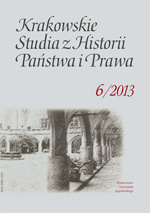Gabinety Królestwa Polskiego 1917–1918. Skład, funkcjonowanie i działalność
The Governments of the Kingdom of Poland ( 1917–1918 ). Members and modes of functioning
Author(s): Jacek GoclonSubject(s): Law, Constitution, Jurisprudence
Published by: Wydawnictwo Uniwersytetu Jagiellońskiego
Keywords: Polish government; First World War; Jan Kucharzewski; Jan Steczkowski; Józef Świeżyński; Kingdom of Poland 1917–1918
Summary/Abstract: The process of restoration of the Kingdom of Poland was started by the Act of 5th November 1916, issued by the governments of Germany and Austria-Hungary (after pushing out the Russian army from Polish territory and establishing the Regency Council). The foundations of Polish state administration were laid by the Regency Council through establishing Polish governments with Prime Ministers. The competencies of the government were delineated by the Act of 3rd January 1918 “about the temporary organization of the head authorities in the Kingdom of Poland”. The act differentiated the executive power into the Prime Minister, the Council of Ministry and the Ministers themselves. The scope of Prime Minister’s duties was defined the Patent of 12th September 1917 and the act of 03th January 1918. Neither of the documents made it clear, however, what authority, and according to what procedure, should appoint the Prime Minister. The new government was approved by the Regency Council only as requested by the already appointed Prime Minister. For sure it highlighted the independency of the “Ministers’ President” from the rest of the government, whose work he supervised. During the time of the Regency Council five cabinets were established, including two provisional governments. Evaluating the cabinets, it should be highlighted that the cabinet of Jan Kucharzewski was the one which actively sought practical experience in managing the Council of Ministry, which later was used by their successors. Their other big achievement was preparation of a lot of projects of legal acts necessary for the development of the new Polish State. The cabinet of Jan Steczkowski continued this process, but after establishing the Council of State in June 1918 (whose role was overestimated) it slowed down in its work of overtaking the successive parts of country administration, and instead started establishing diplomatic offices, which turned out nothing but a faint attempt to show the illusory independency of the Kingdom of Poland. The cabinet of Józef Świeżyński struggled to demonstrate the independency of the Polish government in front of the German and Austrian governments, trying even to distance itself from the Regency Council. It is worth emphasizing the intense work of the provisional governments on taking over the state issues by Polish political subjects. Even though the possibilities of the first cabinets were very limited, they did establish the beginnings of Polish regular state administration and in this way educated the regular state administration officers for the future Polish State.
Journal: Krakowskie Studia z Historii Państwa i Prawa
- Issue Year: 6/2013
- Issue No: 2
- Page Range: 149–178
- Page Count: 30
- Language: Polish

